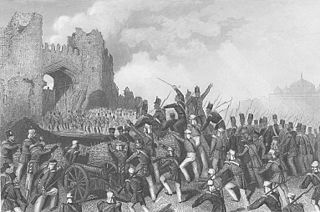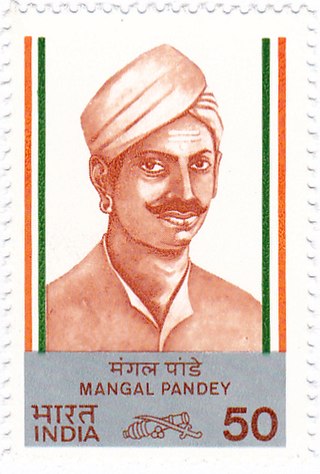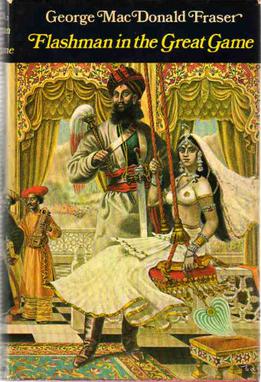The Sepoy Mutiny was a major Indian uprising against British rule in India
Sepoy Mutiny may also refer to:
The Sepoy Mutiny was a major Indian uprising against British rule in India
Sepoy Mutiny may also refer to:

The Indian Rebellion of 1857 was a major uprising in India in 1857–58 against the rule of the British East India Company, which functioned as a sovereign power on behalf of the British Crown. The rebellion began on 10 May 1857 in the form of a mutiny of sepoys of the Company's army in the garrison town of Meerut, 40 mi (64 km) northeast of Delhi. It then erupted into other mutinies and civilian rebellions chiefly in the upper Gangetic plain and central India, though incidents of revolt also occurred farther north and east. The rebellion posed a military threat to British power in that region, and was contained only with the rebels' defeat in Gwalior on 20 June 1858. On 1 November 1858, the British granted amnesty to all rebels not involved in murder, though they did not declare the hostilities to have formally ended until 8 July 1859. Its name is contested, and it is variously described as the Sepoy Mutiny, the Indian Mutiny, the Great Rebellion, the Revolt of 1857, the Indian Insurrection, and the First War of Independence.

Sepoy was the Persian-derived term from the word "sipahi" or a professional Indian infantryman, traditionally armed with a musket, in the armies of the Mughal Empire.
Events in the year 1857 in India.

Major-General The Hon. George Anson CB was a British military officer and Whig politician from the Anson family.

Mangal Pandey was an Indian soldier who played a key role in the events taking place just before the outbreak of the Indian rebellion of 1857. He was a sepoy (infantryman) in the 34th Bengal Native Infantry (BNI) regiment of the British East India Company. In 1984, the Indian government issued a postage stamp to remember him. His life and actions have also been portrayed in several cinematic productions.

Outram is a planning area located within the Central Area of the Central Region of Singapore. The area is bordered by these planning areas: Singapore River to the north, the Downtown Core to the east and south, and Bukit Merah to the west.

Flashman in the Great Game is a 1975 novel by George MacDonald Fraser. It is the fifth of the Flashman novels.
Danapur Cantonment or Danapur Cantt is a cantonment town in Danapur, Patna District in the state of Bihar, India. Danapur is a category II cantonment, established in 1765. The board consists of 14 members including 7 elected members. Danapur Cantonment, located on the outskirts of Patna, is the second oldest cantonment in India, after Barrackpur Cantonment, West Bengal. Danapur is the regimental centre of the Bihar Regiment (BRC). It was earlier called Bankipore Cantonment. Initially, it was set up at Bankipore but later set up in the Danapur area in 1766–67.
Charles Gough may refer to:
Historians have identified diverse political, economic, military, religious and social causes of the Indian Rebellion of 1857.

The 1915 Singapore Mutiny, also known as the 1915 Sepoy Mutiny or the Mutiny of the 5th Light Infantry, was a mutiny involving up to half of a regiment of 850 Indian Muslim sepoys against the British in Singapore during the First World War. The mutiny, on 15 February 1915, lasted nearly seven days. It resulted in the deaths of eight British officers and soldiers, two Malay officers and one soldier, 14 British civilians, five Chinese and Malay civilians and one German internee before it was finally quelled by British forces and Allied naval detachments. More than 205 sepoys were tried by court-martial, and 47 were publicly executed.
The Battle of Badli-ki-Serai was fought early in the Indian Rebellion of 1857, or First War of Indian Independence as it has since been termed in Indian histories of the events. A British and Gurkha force defeated a force of sepoys who had rebelled against the British East India Company. The British victory allowed them to besiege and ultimately capture Delhi.
Sikandar is the Persian rendition of the name Alexander. When the Greek king Alexander the Great conquered Persia, the Persians called him Sikandar, meaning "defender" or "warrior". It is a variant of Iskandar.
The 5th Light Infantry was an infantry regiment of the Bengal Army and later of the raj-period British Indian Army. It could trace its lineage back to 1803, when it was raised as the 2nd Battalion, 21st Bengal Native Infantry. The regiment was known by a number of different names: the 42nd Bengal Native Infantry 1824–1842, the 42nd Bengal Native (Light) Infantry 1842–1861, the 5th Bengal Native (Light) Infantry 1861–1885 and the 5th Bengal (Light) Infantry 1885–1903. Its final designation 5th Light Infantry was a result of the Kitchener Reforms of the Indian Army, when all the old presidency titles (Bengal) were removed. During World War I the regiment was stationed in Singapore and was notorious for its involvement in the 1915 Singapore Mutiny. The regiment was disbanded in 1922, after another set of reforms of the post World War I Indian Army.

Dhan Singh Gurjar, also known as Dhunna Singh, was the Indian Kotwal of Meerut, who participated in the 1857 rebellion and led initial actions against the British East India Company in that city.

Blowing from a gun is a method of execution in which the victim is typically tied to the mouth of a cannon which is then fired, resulting in death. George Carter Stent described the process as follows:
The prisoner is generally tied to a gun with the upper part of the small of his back resting against the muzzle. When the gun is fired, his head is seen to go straight up into the air some forty or fifty feet; the arms fly off right and left, high up in the air, and fall at, perhaps, a hundred yards distance; the legs drop to the ground beneath the muzzle of the gun; and the body is literally blown away altogether, not a vestige being seen.

The Vellore mutiny, or Vellore Revolution, occurred on 10 July 1806 and was the first instance of a large-scale and violent mutiny by Indian sepoys against the East India Company, predating the Indian Rebellion of 1857 by half a century. The revolt, which took place in the Indian city of Vellore, lasted one full day, during which mutineers seized the Vellore Fort and killed or wounded 200 British troops. The mutiny was subdued by cavalry and artillery from Arcot. Total deaths amongst the mutineers were approximately 350; with summary executions of about 100 during the suppression of the outbreak, followed by the formal court-martial of smaller numbers.

The siege of Arrah took place during the Indian Mutiny. It was the eight-day defence of a fortified outbuilding, occupied by a combination of 18 civilians and 50 members of the Bengal Military Police Battalion, against 2,500 to 3,000 mutinying Bengal Native Infantry sepoys from three regiments and an estimated 8,000 men from irregular forces commanded by Kunwar Singh, the local zamindar or chieftain who controlled the Jagdishpur estate.

The Barrackpore mutiny was a rising of native Indian sepoys against their British officers in Barrackpore in November 1824. The incident occurred when the British East India Company was fighting the First Anglo-Burmese War (1824–1826) under the leadership of the Governor-General of Bengal, William Amherst, 1st Earl Amherst.

Rajab Ali Khan, also known as HavildarRajab Ali, was a soldier of the Bengal Regiment who defected during the Sepoy Revolt of 1857. He commanded the rebels at Chittagong and was chased by British forces as far as Sylhet and Manipur.